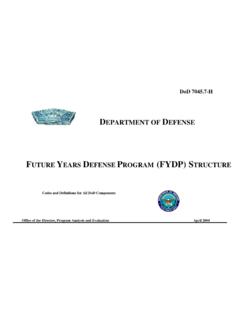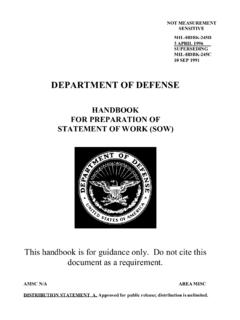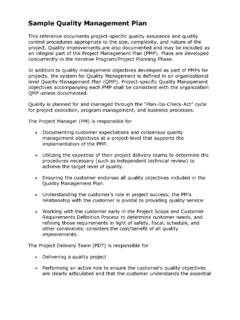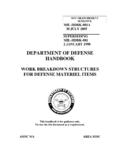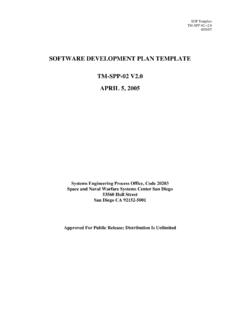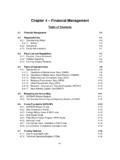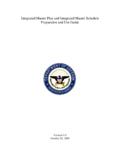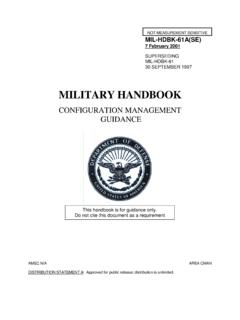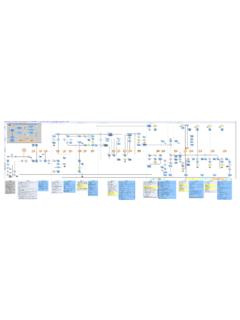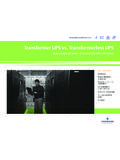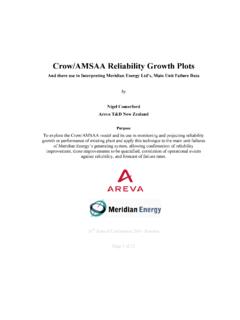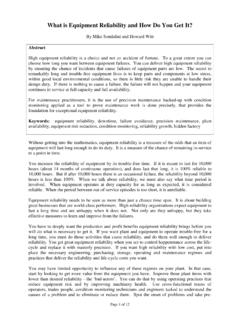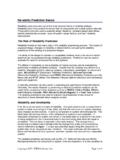Transcription of 1.0 INTRODUCTION TO OPERATIONAL …
1 OPAHS ection 1: INTRODUCTION to OPERATIONAL availability (Ao)1 reliability Analysis Center (RAC) 201 Mill Street, Rome, NY 13440-6916 INTRODUCTION TO OPERATIONAL availability (Ao) IntroductionThis handbook presents a practical overview of the concept of OPERATIONAL availability andseveral supportability measures and their use in different phases of a system's1 life cycle. It ishoped that better understanding of the metrics involved and their derivation will provide insight toprogram sponsors and acquisition managers as they develop and manage their programs. The OPERATIONAL availability (Ao) of systems is key to an organization's ability to be successfulwhile minimizing cost. Our military forces cannot accomplish their missions without effectivesystems and proper support.
2 Military systems must be designed with both effectiveness andsupportability in mind. The acquisition process must be cost-effective and provide the necessaryinfrastructure support to achieve readiness requirements. Supportability considerations must beintegral to nearly all trade-off decisions. Project Managers must be able to assess system performance readiness metrics during theacquisition process, prior to initial OPERATIONAL capability (IOC), and throughout the deploymentcycle, providing feedback critical to ensuring that the user can affordably support the system. Thishandbook is intended to be a practical guide; however although several useful equations areprovided, it is not intended to be an exhaustive mathematical or engineering treatise.
3 This handbook is based on one initially developed, by the Department of the Navy in the mid1980s to address the combined consideration of Ao and cost in all levels of systems acquisition anddesign related decision-making. This handbook generalizes and broadens the application of theconcepts and incorporates the tenets of acquisition reform, organizational re-alignment, andprovides additional clarity to the interaction between Ao and cost of use of terms is essential in this kind of handbook. The DoD and defense industryhave defined material readiness as one of two prime Figures Of Merit (FOM) to be used foracquisition program decision support. The first FOM is the equivalent of material readiness orhardware availability .
4 The second FOM is Total Ownership Cost (TOC) of the system orequipment under consideration. TOC for purposes of this handbook is equivalent to cost ofownership. Although many of the terms and initiatives discussed herein are unique to the military,the basic concepts are also applicable to industrial and commercial products. Understanding AoThe next few paragraphs provide insight to availability and several other important metrics; amore detailed treatise follows in later sections. availability can be generally defined as the probability that a system will be ready to performits mission or function under stated conditions when called upon to do so at a random time. It is a1 For convenience, the term "systems" is used in this handbook to include military weapons systems, industrial systems, andcommercial availability HandbookOPAHR eliability Analysis Center (RAC) 201 Mill Street, Rome, NY 13440-6916 1-888-RAC-USER term associated with systems that can be repaired or have other maintenance performed.
5 As such, availability is a function of how often the system fails (a function of reliability ) and how long ittakes to restore the system to an OPERATIONAL condition after a failure occurs (a function ofmaintenance and support). For systems for which no maintenance is possible or practical (not eveninspections or servicing), availability is equal to the system reliability . reliability can be definedas the probability that a system will perform its function(s) as required when used under statedconditions for a given interval of time without the general definition of availability is modified to assume ideal support ( , unlimitedspares, no delays, etc.) and only design- or manufacturing-related failures are considered, we haveinherent availability (Ai).
6 Ai reflects the level of reliability and maintainability (R&M) achievedin the design and realized through the manufacturing, assembly, and, in some cases, a realistic support environment is considered and all maintenance actions, even thosenot required as a result of design- or manufacturing-related failures, are considered, we haveoperational availability (Ao). Ao is a function of reliability , maintainability , and effort should be made to explicitly consider each element of Ao in early development andthroughout the system's life cycle. As you use this handbook, keep two important things in mind;first and foremost, OPERATIONAL availability is a key element in determining system readiness2 anda supportability goal. Second, the system design does not solely determine Ao, but dictates amaximum level of availability based only on the designed-in levels of R&M.
7 reliability is oftenexpressed in terms of the Mean Time Between Failure (MTBF) and maintainability in terms ofMean Time To Repair (MTTR). Figure helps us to better understand the difference between Ai and Ao. Note that nomatter how it is measured, availability can never be more than 100% ( ) or less than is often mistakenly equated to reliability . reliability is a function based on theactual physical components in the design and is generally defined as the probability that an item2 Readiness is a broader term that accounts for the number and level of training of operating personnel; command, control, andcommunications, mobility; planning; strategy and tactics; and other AvailabilityThe level of R&M achieved in design and the fidelity of the manufacturing AvailabilityThe level of R&M achieved in design, the fidelity of the manufacturing processes, maintenance policy, in-theater assets, order/ship times.
8 MTBF is the mean time between "hard" failuresMTTR is the mean time to repair as a function of designMTBM is the mean time between maintenance, all corrective and preventive maintenanceMDT is the mean downtime, which includes the actual time to perform maintenance and accounts for any delays in getting the needed personnel or parts, number of spares on hand, Logistics Impact on OPERATIONAL AvailabilityAiMTBFMTBF + MTTR------------------------------------ ---=AoMTBMMTBM + MDT------------------------------------- -=OPAHS ection 1: INTRODUCTION to OPERATIONAL availability (Ao)3 reliability Analysis Center (RAC) 201 Mill Street, Rome, NY 13440-6916 1-888-RAC-USER will not fail to perform its function(s) when used under stated conditions over a defined timeperiod.
9 When the times to (for non-repairable items) or times between failures are exponentiallydistributed, the equation for reliability is:where:e is the natural logarithm (lambda) is the failure ratet is the time period for which the reliability is calculatedReliability, being a probability, can take on any value between 0 and 1. Often reliability isexpressed as MTBF. For the exponential distribution of failure times, the MTBF is the inverse ofthe failure rate ( ). For example, if a system failure rate is 5 failures per thousand hours, it followsthat the MTBF is equal to 200 hours. reliability is an important factor in availability . Another factor of availability ismaintainability. maintainability is often defined as "the measure of the ability of an item to beretained in or restored to a specified condition when maintenance is performed by personnel havingspecified skill levels, using prescribed procedures and resources, at each prescribed level ofmaintenance and repair.
10 " Other reference documents define maintainability in slightly differentways. In an important way, many of these definitions are incomplete. maintainability is concernedwith the relative ease and economy of preventing failures (retaining an item in a specifiedcondition) or correcting failures (restoring an item to a specified condition) through maintenanceactions. So, good maintainability is not simply the ability to keep a product operating usingprescribed procedures and resources. It is the ability to do so economically and the ideas in the definitions found in various references and adding the idea ofeconomy, yields the following definition: maintainability . The relative ease and economy of time and resources with which an itemcan be retained in, or restored to, a specified condition when maintenance is performed bypersonnel having specified skill levels, using prescribed procedures and resources, ateach prescribed level of maintenance and repair.
